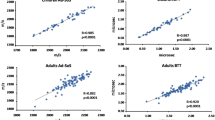Abstract
Skeletal status in subjects with genetic disorders rarely has been a matter of interest, and the risk for osteoporotic fracture in this population is not known. The aim of this study was to estimate ultrasound values in subjects with genetic disorders. In the study 50 patients (36 boys and 14 girls, mean age 11.8±2.9 years) and 528 healthy controls matched for age and body size (380 boys and 148 girls, mean age 11.9±2.5 years) were evaluated. Patients with the following disorders were included: Down syndrome, Martin-Bell syndrome, Marfan-Mass phenotype and others. Bone status was assessed by quantitative ultrasound (QUS) of hand phalanges using DBM Sonic 1200 (IGEA, Carpi, Italy), which measures amplitude-dependent speed of sound (Ad-SoS, m/s). Ad-SoS was significantly lower in patients than in controls (in the whole group 1,915±69 m/s vs. 1,970±62.0 m/s, P<0.0000001; in males 1,917±73 m/s vs. 1,972±63 m/s, P<0.000001; in females 1,910±58 m/s vs. 1,963±58 m/s, P<0.01). Ad-SoS correlated significantly with age and body size (except for Ad-SoS with age in female patients). In all subgroups of patients (except for the subjects with Marfan-Mass syndrome) Ad-SoS values were significantly lower than in controls. In a multiple, stepwise regression analysis of Ad-SoS on age and body size, in the whole group of patients age and height had significant influence on Ad-SoS, and in controls age, height and weight. In conclusion, the study shows significantly lower phalangeal ultrasound values in subjects with different genetic disorders compared to normal healthy persons.

Similar content being viewed by others
References
Aspray TJ, Francis RM, Thompson A, Quilliam SJ, Rawlings DJ, Tyrer SP (1998) Comparison of ultrasound measurements at the heel between adults with mental retardation and control subjects. Bone 22:665–668
Angelopoulou N, Souftas V, Sakadamis A, Mandroukas K (1999) Bone mineral density in adults with Down's syndrome. Eur Radiol 9:648–651
Nakken KO, Lossius R (1993) Seizure related injures in multihandicapped patients with therapy-resistant epilepsy. Epilepsia 34:836–840
Halaba Z, Pluskiewicz W (1997) The assessment of development of bone mass in children by quantitative ultrasound through the proximal phalanxes of the hand. Ultrasound Med Biol 23:1331–1335
Baroncelli GI, Federico G, Bertelloni S, et al (2001) Bone quality assessment by quantitative ultrasound of proximal phalanxes of the hand in healthy subjects aged 3–21 years. Pediatr Res 49:713–718
Pluskiewicz W, Drozdzowska B (1998) Ultrasound measurements of proximal phalanges in Polish early postmenopausal women. Osteoporos Int 8:578–583
Mauloni M, Rovatti LC, Cadossi R, de Terlizzi F, Ventura V, de Aloysio D (2000) Monitoring bone effect of transdermal hormone replacement therapy by ultrasound investigation at the phalanx: a 4-year follow-up study. Menopause 7:402–412
Pluskiewicz W, Drozdzowska B (1998) Ultrasound measurement of proximal phalanges in a normal Polish female population. Osteoporos Int 8:349–354
Ventura V, Hans D, Schott AM, Giraud S, Delmas PD, Meunier PJ (1996) Ultrasound velocity measured at the proximal phalanges: precision and age-related changes in normal females. Rev Rhum 63:427–434
Alenfeld FE, Wüster C, Funck C, et al (1998) Ultrasound measurements at the proximal phalanges in healthy women and patients with hip fractures. Osteoporos Int 8:393–398
Joly J, Westhovens R, Borghas H, et al (1999) Reference curve and diagnostic sensitivity for a new ultrasound device for the phalanges, the DBM Sonic 1200, in Belgian women. Osteoporos Int 9:284–289
Lippuner K, Fuchs G, Ruetsche AG, Perrelet R, Casez JP, Neto I (2000) How well do radiographic absorptiometry and quantitative ultarasound predict osteoporosis at spine or hip? J Clin Densitom 3:241–249
Wüster C, Albanese C, De Aloysio D, et al (2000) Phalangeal osteosonogrammetry study: age-related changes, diagnostic sensitivity, and discrimination power. J Bone Miner Res 15:1603–1614
Mele R, Masci G, Ventura V, de Aloysio D, Bicocchi M, Cadossi R (1997) Three-year longitudinal study with quantitative ultrasound at the hand phalanx in a female population. Osteoporos Int 7:550–557
Gluer CC, Blake G, Lu Y, Blunt BA, Jergas M, Genant HK (1995) Accurate assessment of precison errors: how to measure the reproducibility of bone densitometry techniques. Osteoporos Int 4:262–270
Kao C, Chen CC, Wang SJ, Yeh SH (1992) Bone mineral density in children with Down syndrome detected by dual photon absorptiometry. Nucl Med Commun 13:773–775
Sepulveda D, Allison DB, Gomez JE, et al (1995) Low spinal and pelvic bone mineral density among individuals with Down syndrome. AMJR 100:109–114
Author information
Authors and Affiliations
Corresponding author
Rights and permissions
About this article
Cite this article
Pluskiewicz, W., Pyrkosz, A., Drozdzowska, B. et al. Quantitative ultrasound of the hand phalanges in patients with genetic disorders: a pilot case-control study. Osteoporos Int 14, 787–792 (2003). https://doi.org/10.1007/s00198-003-1400-9
Received:
Accepted:
Published:
Issue Date:
DOI: https://doi.org/10.1007/s00198-003-1400-9




